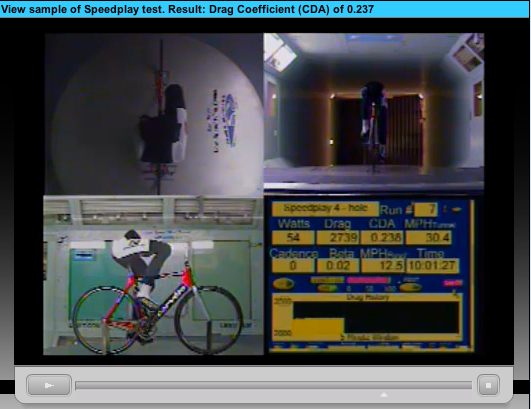Then, man—has Speedplay got the pair of pedals for you.
In a claim worthy of Chesterfield Cigarettes, Speedplay has asserted that wind tunnel testing has proved its pedals will save you an astounding 33 seconds per hour if you use the four bolt attachment.
There are, of course, the obvious problems with this wind-tunnel derived claim—you don’t ride hour-long time trials; even if you did, you couldn’t ride them a consistent 30mph; even you could, they have hills and corners, and you’re overweight and a lousy bike handler. Then there are cross-winds, other competitors, traffic, mental toughness, etc.
But in this post I will ignore these things. Instead, I want to focus on highlighting Speedplay’s ill-conceived methodology and misleading conclusions.
“…the testing of a single component by itself raises questions as to whether or not the component will perform in the same way when installed on a bicycle and used outside of the tunnel.
With this in mind, we mechanized a life-size, lower-half of a mannequin so the mannequin, rather than a person, would pedal the bike.
Yes, you read that correctly—the problem with wind tunnel tests is that they’re not like real life, so we replaced a real life person with a torso-less pair of mechanical legs. Does its motion churn the surrounding air like a real human set of legs? Are its proportions correct? What about foot position—idealized by biomechanics, or average observed foot position of pro riders? These are questions Speedplay didn’t feel like addressing.
At any rate, Speedplay’s use of de-torsoed legs in means that the results—in the unit-less and not particularly useful form of coefficient of drag—apply only to this mannequin. When this bodiless apparatus is wears shoes with 4-bolt-mounted Speedplays, that coefficient is .237.
However, Biomechanics and Biology of Movement found that “a cyclist on a standard road bike in racing position” has a drag coefficient of 0.78. That 200% increase reflects all the things Speedplay’s disembodied legs left out of their results.
So what appeared to be a small difference in coefficient of drag—2.5%—is actually an all-but-insignificant 0.7%*. And even that minor change requires to you have faith in the reliability of Speedplay’s procedures. Measuring drag coefficient to three significant digits—the finest measure available from the wind tunnel if Speedplay’s videos are any indication—and coming away with a single thousandth of variation invites far closer scrutiny of the study.
Sadly, Speedplay states only that the tests ran for five minutes, at a cadence of 100 rpm, and a headwind of 30mph. Data on number of trials for each pedal design, and variation in wind speed during the course of each trial would be more than welcome, but are entirely lacking.
Speedplay offers similarly little help in saying exactly what “available data” lead them to infer that the advantage to their pedal is “equivalent to the speed gained when switching from a standard front wheel to a deep-profile, aerodynamic front wheel.” The only data I could find using coefficient of drag were from Greenwell, which describes aero wheel advantages roughly two to ten times more pronounced than anything measured by Speedplay in this testing.
So, Speedplay—as far as I can tell, you’re lying to sell more gear. You certainly wouldn’t be the only ones. But I’d hate to stand here casting such aspersions without giving you a chance explain or clarify your findings.
I want to see the precise data behind this test—with detailed descriptions of apparatus, methods, and raw results. I’d also like to know the names and qualifications of those who designed and carried out this test. Finally, I’d like to see what research you used to conclude that, based on the data in this test, Speedplay pedals deliver such marked aerodynamic savings.
My request for this data is genuine. Readers and tech editors alike will tell you I’m receptive to criticism and more than willing publish your response.
*actually, I’m told that the increased surface area of a full-sized rider would make the coefficient of drag an even less relevant than the absolute value I’ve derived here.


If anybody is buying a specific pedal because they think they’ll get an aerodynamic, they need to be shunned. Hard.
Pardon me. Incomplete sentence. An aerodynamic *advantage* is what I meant to write.
Speedplay has done this a lot – they used to (they might still!) advertise their pedals as weighing dramatically less than regular pedals, which is true until you account for the fact that all the metal and heavy stuff is in the cleat, so the systems are about comparable.
I’d be interested in trying out Speedplay pedals, but I sure can’t stand their advertising.
I agree that Speedplay failed to post some useful info in that analysis, such as the shoes used and if the same saddle height was used for both shoe/pedal combinations. However, the 0.237 number is not Cd, but CdA (coefficient of drag * frontal area). Poor choice of words on Speedplay’s part in that caption.
Typical frontal area of a racing cyclist is << 1 m^2, so the CdA tends to be a much lower number than just Cd. In fact, 0.237 is just a so-so number for a whole cyclist in TT position in a wind tunnel, so I suspect that the headless torso actually is not as slippery as a whole person.
Anyhoo, a .006 improvement in CdA will get you about 0.4 Km/h faster on a flat course at 250W. Which, of course, only exists in the analyticcycling.com model that I constructed quickly to get some numbers.
I’ve ridden Speedplay pedals since about 1994 or so, I’ve owned multiple pair of the X-2 Stainless and X-1 Ti, as well as the CrMo Zeros. I have nothing but love for these pedals. I think entry/exit is probably better on the X series, but the Zeros give you the option of limiting or elimination the float, so there’s that. They really are pretty light, too, even when you include the cleat, which is more plastic than metal.
Having said all of that, the aerodynamic claims are amongst their worst yet. But if your product is relatively unchanged for years, as Speedplay’s is, you have to have something new to crow about, and everyone loves getting more aero lately…
Other concerns aside (cadence, etc), I really question how well speedplay’s methodology really captures the pedaling motion itself, which I would wager has a drastic impact on pedal aerodynamics. If you watch the video speedplay offers on their site, it reveals that the angle of their model’s ankle changes only very slightly. But… in the real world, many people, especially at upper ends of the sport, pay a lot of attention to training a pedal stroke that scoops through the bottom of the stroke (ankling if you want to use the common term), which often leads to exposing much, much less of the actual pedal body to the wind on the upward half of the pedal stroke as the toe is angled much further downward than assumed. Speedplay’s “advantages” may exist, but they likely only exist during half a normal pedal stroke.
All I know is that my Speedplays (Light Action) likely saved/are saving my knees. CdA be damned.
A nod to Cosmo’s 2nd paragraph. I’m just some Fred who wanted a pair of pedals that felt right and performed well. Do they really need to market themselves as the next aero revolution?
As Christian mentions above, it looks like the model year problem is showing it’s ugly self again.
Training an extra 50km and drinking one less beer per week will improve your performance more than their pedals will.
Interesting comment from Andy MJ re weight of cleats. I never thought of it that way.
Awesome, I would have bought the pedals for the >100% reduction in training. Now you tell me I can drink more too!
isn’t saving 33 seconds per hour some sort of einstein-relativity-advanced-physics thing?
like having two watches set to the same time and having one in an airplane, with the result being that the time moves more slowly for the watch on the plane?
so by using speedplays and going faster, your hour time trial is actually not an hour, but 59:27, according to the theory of relativity. but that would be according to your computer on your bike, which is moving fast. the official’s clock, which is stationary, would still say one hour.
so i guess that is why whenever i time myself in a tt, the time that i get is always better than i see in the official results.
To James above : Could CDA be a mere 0.242? First of all, if that’s the case it can’t be dimensionless so it must be 0.242m^2.
Next, in some papers I have read on wind tunnel testing, the frontal area of a top 180cm 73kg pro cyclist on a bike in aero position was 0.31 m^2. That of the slick TT bike he was riding was 0.11m^2 for a total of 0.42m^2. These numbers were measured by planimetry.
If the CDA in speedplay’s case is to be 0.242, which is much lesser than the frontal area of the above rig in the study, the Cd of the robot must be what?
Let’s make some assumptions. If we take the cyclist I mentioned above and assume that his lower legs have 1/2th the total frontal area, that’s about 0.15m^2. If we assume that the robot legs had a similar looking frontal area and the bike had about 0.11m^2, total area is 0.26m^2 for the half robot and bike. Then the drag co-efficient has to be about 0.93 so that CdA is 0.242.
Is 0.93 big for Cd for a crude figure in the form of a robot’s legs pedaling a bike? For perspective, its 0.78 for a cyclist in racing position. So its possible that you’re right and that Speedplay made a typing mistake.